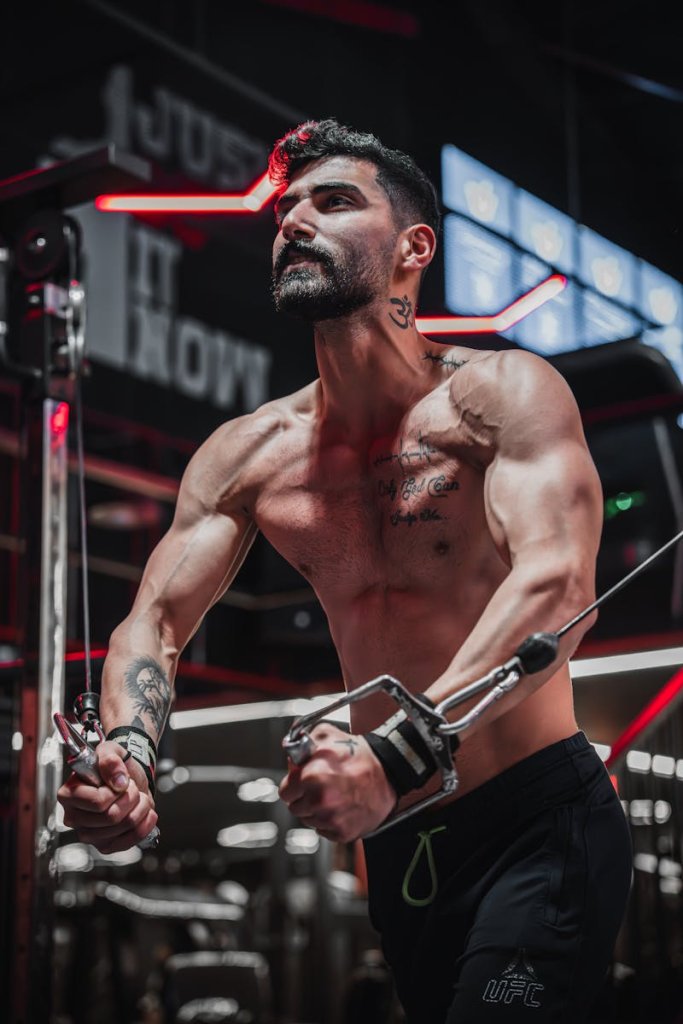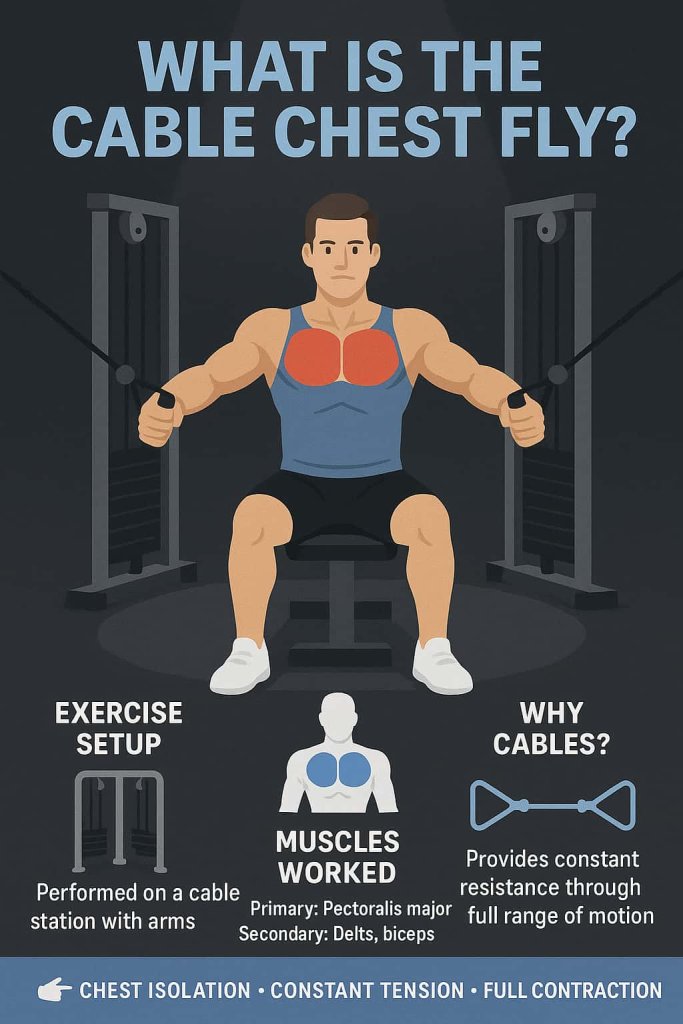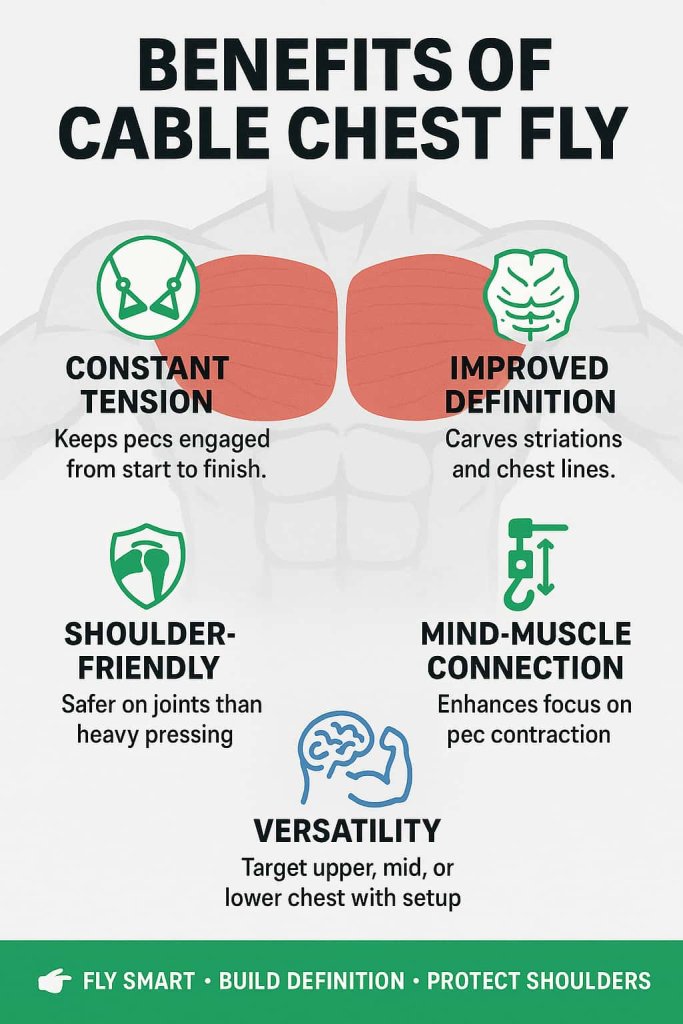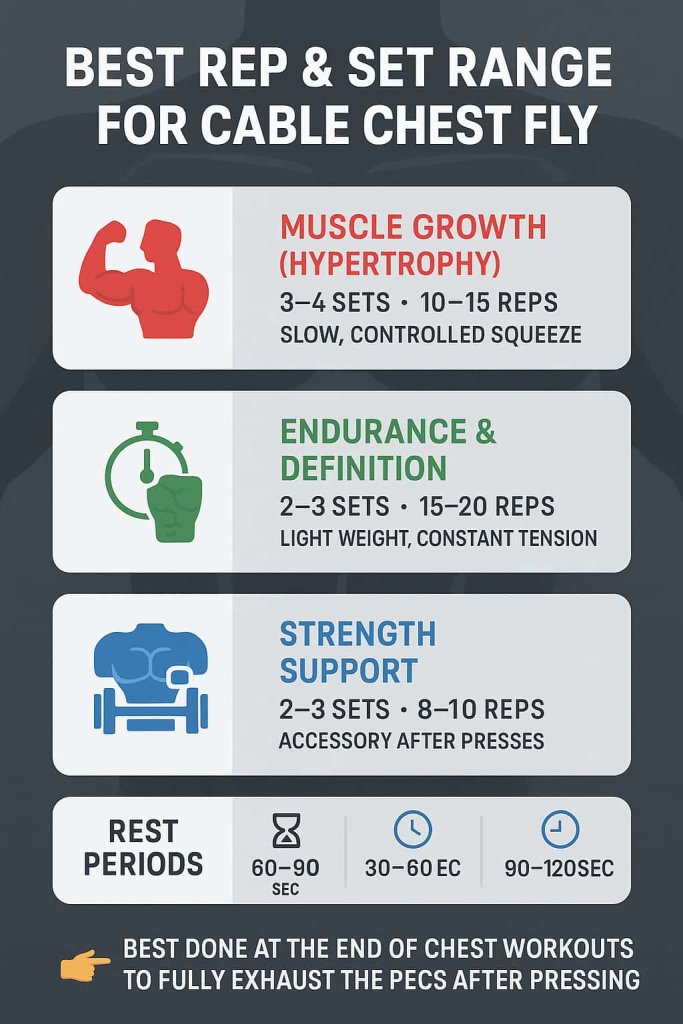Yes, the cable chest fly is one of the best exercises for sculpting pecs because it keeps constant tension on the chest throughout the movement. Unlike dumbbell flys, where resistance drops at the top, cables provide consistent load from start to finish. This makes it one of the most effective moves for definition, hypertrophy, and balanced chest development.

Mastering proper form is crucial, though. Done wrong, the exercise can strain your shoulders or arms instead of targeting your pecs. Below, we’ll break down the key form tips, benefits, common mistakes, and expert trainer advice.
What Is the Cable Chest Fly?
The cable chest fly is a chest isolation exercise performed using a cable crossover machine. By bringing your arms together in a wide, hugging motion, you emphasize the pectoral muscles through their full stretch and squeeze.

- Primary muscles worked: Pectoralis major (sternal and clavicular heads)
- Secondary muscles: Anterior deltoids, biceps, and serratus anterior
Because the resistance curve is smooth and adjustable, cables make it easier to control the movement compared to dumbbells.
Benefits of Cable Chest Fly

- Constant tension: Keeps chest muscles engaged throughout the movement.
- Improved definition: Great for carving striations and chest lines.
- Shoulder-friendly alternative: Safer on the joints compared to heavy barbell pressing.
- Mind-muscle connection: Helps isolate pecs without relying on triceps or delts.
- Versatility: Can be performed high, mid, or low to target different chest fibers.
👉 Adjusting pulley height is key to targeting the upper, mid, or lower chest effectively.
5 Form Tips for Perfect Cable Chest Fly
1. Set Pulleys at Shoulder Height
For mid-chest activation, adjust the handles around shoulder level. If you want to emphasize the upper chest, set them lower, and for lower pecs, set them higher. This ensures the line of resistance matches the muscle fibers you’re targeting.
2. Maintain a Slight Elbow Bend
Never lock your elbows. Keep a soft bend throughout the motion and move from the shoulder joint. This prevents unnecessary elbow strain and ensures the pecs, not arms, do the work.
3. Brace Your Core and Keep Posture Strong
Avoid leaning too far forward or arching excessively. Brace your core, keep chest up, and feet staggered for stability. This prevents momentum from taking over and maximizes chest tension.
4. Retract Shoulder Blades
Think of “pinching a pencil” between your shoulder blades. This stabilizes the shoulder joint, keeps tension in the chest, and avoids overuse of the front delts.
5. Control the Squeeze—Don’t Slam Handles Together
Stop just before the handles touch. Focus on squeezing your chest at the midline instead of clashing the cables. Slowly return to the starting position under control for maximum time under tension.
👉 Many lifters benefit from pausing for one second at peak contraction.
Cable Chest Fly Variations
While the standard mid-level cable chest fly is excellent, changing pulley height or stance lets you emphasize different chest fibers. Adding variations keeps your workouts effective, prevents plateaus, and ensures balanced pec growth.
1. High-to-Low Cable Fly
- How to Do It: Set pulleys above shoulder height. Pull handles downward and inward in an arcing motion until hands meet near the waistline.
- Muscles Worked: Emphasizes the lower portion of the pecs.
- Trainer Tip: Keep a slight forward lean, but avoid rounding shoulders.
2. Low-to-High Cable Fly
- How to Do It: Set pulleys at the lowest setting. Pull handles upward in a hugging arc until they meet at upper chest or face height.
- Muscles Worked: Targets the upper chest (clavicular head).
- Trainer Tip: Think about “lifting your chest to the sky” to keep tension in the pecs rather than shoulders.
3. Single-Arm Cable Fly
- How to Do It: Perform flys with one arm at a time, keeping the other hand on your hip or bench for balance.
- Muscles Worked: Allows deeper contraction and improved focus on the working pec.
- Trainer Tip: Pause slightly at peak contraction to build a stronger mind-muscle connection.
4. Seated Cable Fly
- How to Do It: Place a bench in the middle of the cable station and sit upright with pulleys at chest height. Perform flys with strict, controlled motion.
- Muscles Worked: Engages mid-chest while removing balance challenges.
- Trainer Tip: Great for beginners because it eliminates lower-body involvement and forces pec isolation.
Best Rep & Set Range for Cable Chest Fly

The cable chest fly works best when performed with controlled reps and moderate weight. Since it’s an isolation movement, the goal is not max strength but muscle activation and hypertrophy.
- For Muscle Growth (Hypertrophy):
3–4 sets of 10–15 reps with slow, controlled form. Focus on squeezing at the midline and lowering with control. - For Endurance & Definition:
2–3 sets of 15–20 reps with lighter weight. Maintain constant tension for maximum chest burn. - For Strength Support:
Use cable flys as an accessory after heavy presses. Perform 2–3 sets of 8–10 reps with slightly heavier weight, ensuring form remains strict. - Rest Periods:
- 60–90 seconds between hypertrophy sets
- 30–60 seconds for endurance
- 90–120 seconds for heavier strength-based sets
👉 Experts recommend performing cable flys at the end of your chest workout to fully exhaust the pecs after heavy pressing movements
Common Mistakes to Avoid
- Using too much weight and relying on momentum.
- Locking out or hyperextending the elbows.
- Allowing shoulders to roll forward (puts stress on joints).
- Rushing through reps instead of focusing on squeeze.
- Crossing arms excessively, which reduces pec tension.
Trainer Tips for Better Results
- Perform 3–4 sets of 10–15 controlled reps.
- Use light-to-moderate weight to prioritize form over load.
- Try single-arm cable flys for improved focus and chest activation.
- Incorporate different angles weekly for complete pec development.
- End chest workouts with flys to fully exhaust the pecs after pressing movements.
FAQs About Cable Chest Fly
1. Is cable chest fly better than dumbbell fly?
Yes, cables provide constant tension, while dumbbells lose resistance at the top.
2. What’s the best angle for cable chest fly?
Shoulder height targets mid-pecs, low pulley targets upper chest, and high pulley emphasizes lower pecs.
3. Can beginners do cable flys?
Yes, start with light weight and focus on form before progressing.
4. Should I cross my arms during flys?
No, stop at chest level for maximum squeeze without losing pec tension.
5. How many times per week should I do cable flys?
2–3 times per week, ideally at the end of your chest workout.
6. Do cable flys build muscle or just definition?
Both. With progressive overload, cable flys can stimulate hypertrophy while also improving definition.
7. Are cable flys safe for shoulders?
Yes, when done with correct form and moderate weight, they’re safer than heavy presses.
Conclusion
The cable chest fly is one of the most effective exercises for sculpting a defined, muscular chest. By following the five form tips—setting pulley height correctly, keeping elbows bent, bracing your core, retracting your shoulders, and controlling the squeeze—you’ll maximize pec activation while protecting your joints.
Adding variations and using the right rep/set ranges ensures complete chest development, whether your goal is mass, definition, or endurance.
Ready to build a stronger chest? Next time you’re at the gym, apply these tips and feel the difference immediately.
